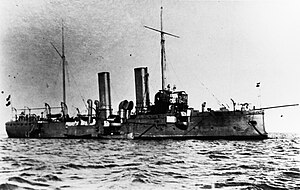 Leopard, date unknown
| |
| History | |
|---|---|
| Name | Leopard |
| Laid down | January 1885 |
| Launched | 10 September 1885 |
| Completed | 31 March 1886 |
| Fate | Broken up, 1920 |
| General characteristics | |
| Class and type | Panther-class cruiser |
| Displacement | 1,557 long tons (1,582 t) |
| Length | 73.19 m (240 ft 1 in) |
| Beam | 10.39 m (34 ft 1 in) |
| Draft | 4.28 m (14 ft 1 in) |
| Installed power |
|
| Propulsion |
|
| Speed | 18.7 knots (34.6 km/h; 21.5 mph) |
| Range | 2,800 nmi (5,200 km; 3,200 mi) at 10 knots (19 km/h; 12 mph) |
| Crew | 186 |
| Armament |
|
| Armor | Deck: 12 mm (0.47 in) |
SMS Leopard was a torpedo cruiser (Torpedoschiff) of the Austro-Hungarian Navy. She and her sister ship, SMS Panther, were part of a program to build up Austria-Hungary's fleet of torpedo craft in the 1880s. Both ships, the only members of the Panther class, were built in Britain at the Armstrong shipyard in Elswick. Leopard was laid down in January 1885, launched in September 1885, and completed in March 1886. She was armed with a battery of two 12 cm (4.7 in) guns and ten 47 mm (1.9 in) guns, along with four 356 mm (14 in) torpedo tubes.
Leopard spent much of her career in the main Austro-Hungarian fleet. During this period, she visited Spain for the 1888 Barcelona Universal Exposition, and took part in an international naval demonstration off Crete in 1897 in an attempt to limit the Greco-Turkish War. From 1900, Leopard made two major overseas deployments, including a tour of the Pacific Ocean in 1900–1901, and a stint in the East Asia squadron in 1907–1909. Upon returning to Austria-Hungary, the ship was modernized in 1910 and then decommissioned in May 1914, shortly before the start of World War I in July. The ship was immediately reactivated and stationed in Pola as a guard ship, where she remained for the duration of the conflict. After Austria-Hungary's defeat, Leopard was ceded to Britain as a war prize and sold to ship breakers in Italy in 1920.